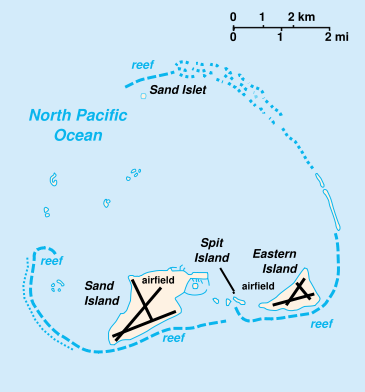| Previous: On The Ship. The Departure From LA | Next: Page 5 - Midway Atoll Photos |
Where Is Midway?
Some 27 million years ago a volcanic island emerged from the sea over a "hot spot" in the Pacific plate, located near what is now the site of the Big Island of Hawaii. As the plate moved northwest, the Hawaiian Island chain was formed, with Midway and Kure, ending up at the northwestern end. Part of the Hawaiian archipelago, Midway Atoll lies about 1200 miles northwest of Honolulu, 2800 miles west of San Francisco, and 2200 miles east of Japan -- midway across the Pacific, hence the name. The International Date Line is 140 miles west of Midway.
At one time, Midway was an island about the size of the present Hawaiian island of Lanai. However, over millions of years, wind, rain and waves eroded the island, wearing the land down. As the land mass at Midway submerged, reef-building corals created a ring around the sinking mountain top. Today the basalt of Midway's volcano is buried under more than 500 feet of calcium carbonate. What remains above the surface is the coral reef that surrounds the atoll.
 Midway Atoll (also known as Midway Island or Midway Islands, Hawaiian: Pihemanu) is a 2.4 square mile (6.2 km²) atoll located in the North Pacific Ocean (near the northwestern end of the Hawaiian archipelago) at 28°13′N 177°22′ W about one-third of the way between Honolulu and Tokyo. It is less than 140 nautical miles east of the International Date Line, about 2,800 nautical miles west of San Francisco and 2,200 nautical miles east of Tokyo.
Midway Atoll (also known as Midway Island or Midway Islands, Hawaiian: Pihemanu) is a 2.4 square mile (6.2 km²) atoll located in the North Pacific Ocean (near the northwestern end of the Hawaiian archipelago) at 28°13′N 177°22′ W about one-third of the way between Honolulu and Tokyo. It is less than 140 nautical miles east of the International Date Line, about 2,800 nautical miles west of San Francisco and 2,200 nautical miles east of Tokyo.
It consists of a ring-shaped barrier reef and several sand islets. The two significant pieces of land, Sand Island and Eastern Island, provide habitat for hundreds of thousands of seabirds.
The atoll, which has a tiny population (40 in 2004, but no indigenous inhabitants), is an unincorporated territory of the United States, designated an insular area under the authority of the U.S. Department of the Interior.
It is a National Wildlife Refuge administered by the U.S. Fish and Wildlife Service (FWS). The visitor program closed in January 2002 and there are no facilities at the present time for receiving visitors. However, visitors who are able to provide their own transportation can contact the refuge manager for information on visiting the atoll.

The economy is derived solely from governmental sources. All food and manufactured goods must be imported. Midway, as its name suggests, lies nearly halfway between North America and Asia. It also lies almost halfway around the earth from Greenwich, England.
Midway And WWII
Midway is best known as the location of the Battle of Midway, fought in World War II on June 4, 1942. Nearby, the United States Navy defeated a Japanese attack against the Midway Islands, marking a turning point in the war in the Pacific Theater. For statistical purposes, Midway is grouped as one of the United States Minor Outlying Islands.
What's An Atoll??
An atoll is an oceanic reef formation, often having a characteristic ring-like shape surrounding a lagoon. Atolls are formed when coral reef grows around a volcanic island that later subsides into the ocean.
 This animation shows the dynamic process of coral atoll formation.
This animation shows the dynamic process of coral atoll formation.
Corals (represented in tan and purple) settle and grow around an oceanic island, forming a fringing reef. In favorable conditions, the reef will expand, and the interior island will subside.
Eventually the island completely subsides beneath the water, leaving a ring of growing coral with an open lagoon in its center.
The process of atoll formation may take as long as 30 million years to occur.
Weather Expectations
Midway has a sub-tropical climate that is moderated by prevailing easterly winds. There are two distinguishable seasons at Midway: summer and winter. Temperatures in the summer, approximately May to October, are typically warm, with sunny days and cooler nights. Air temperatures at this time of year usually range between 70 to 85 degrees. During winter months, November to April, temperatures average in the 60s and can sometimes dip into the 50s. Winter days are more likely to bring rain and wind also, making it cold enough to require a warm sweater or jacket. The lowest and highest temperatures recorded at Midway are 54 and 92 degrees. Water temperatures at Midway range from the mid-60s in winter to the high-70s during summer months. Average annual rainfall is 42 inches. Although rainfall is generally heavier during winter months, it can rain at any time of the year on Midway. A rain slicker is useful for visitors throughout the year, as the primary modes of transportation on Midway are walking and bicycling.
Average High Temperature during the month of Jun:81.0 Fahrenheit
Average Low Temperature during the month of Jun:73.0 Fahrenheit
Average Morning Relative Humidity during the month of Jun:81.0 percent
Average Number of Days Above 80F/26C during the month of Jun:20.0 Days
Average Number of Days Above 90F/32C during the month of Jun:0.0 Days
Average Number of Days With Thunderstorms during the month of Jun:0.0 Days
Average Precipitation during the month of Jun:2.0 inches/5.0 centimeters
Average Wind Speed during the month of Jun:10.0 miles per hour
Highest Recorded Temperature during the month of Jun:89.0 Fahrenheit
Least Recorded Rainfall during the month of Jun:0.0 inches
Most Recorded Rainfall during the month of Jun:13.0 inches
Gooney Birds

Everywhere
| Previous: On The Ship. The Departure From LA | Next: Page 5 - Midway Atoll Photos |